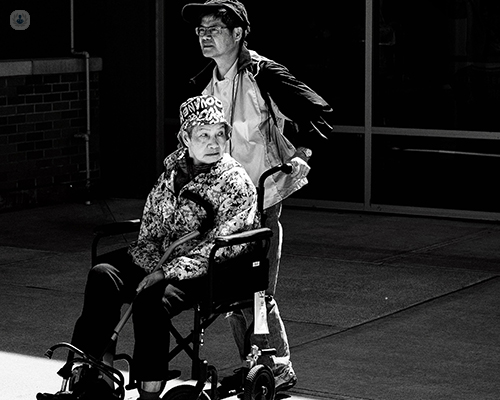Revision hip replacement: why do hip replacements fail?
Written by:Hip replacement is generally a very successful procedure in relieving the pain and stiffness associated with a damaged hip joint. Most patients forget about the artificial joint by about 3 months after the operation. Approximately 90% of hip replacements last longer than 10 years and 80% longer than 20 years.
However, hip replacements can fail and there are several reasons why this can happen. Expert orthopaedic surgeon Mr Nick de Roeck explains why.

Loosening
The most common reason for failure is loosening. The components that are fixed into the bone slowly become loose over time, leading to the joint becoming painful again. The reason this happens is that the parts that move in a hip replacement, called the bearing surfaces, are made of artificial materials which can slowly wear. Over several years, sufficient microscopic worn material can be released to cause an inflammatory response within the joint. This response can damage the bone and eventually lead to loosening of the artificial hip.
The extent of this response seems to vary between patients for reasons we don’t fully understand. If the hip replacement becomes sufficiently loose to cause pain, then further surgery to revise or replace the worn or loose components may be needed.
Dislocation
The second most commonly recorded reason for failure of a hip replacement is dislocation, or the ball being able to jump out of socket. If a hip replacement dislocates, the leg is shortened and becomes very painful. It is not possible to bear weight and patients have to return to hospital to have the joint relocated. This usually has to be performed under anaesthesia.
The period with the highest risk for dislocation is in the first three months after surgery, whilst the deeper healing occurs. After this early period the risk diminishes. The risk of dislocation can increase again in hip replacements that have been in place for many years. This can reflect the joint wearing out. In older patients, weakening of muscles or loss of cognitive function can also contribute to dislocations. If a patient suffers several dislocations, it likely that it will continue to happen and so they may be offered further surgery to try and resolve the problem.
Infection
Perhaps the most devastating reason that can arise leading to the failure of a hip replacement is a deep infection around the prosthesis. The most likely time for infection to be introduced is at the time of the initial surgery, so great precautions are taken to minimise this risk. These include trying to minimise patient risk factors in advance, performing very careful surgery and using prophylactic antibiotics. In the UK, surgery takes place in special ultra-clean air or laminar flow operating theatres.
Despite these precautions, infections can occur. Occasionally, infections in other parts of the body can spread to a joint replacement and lead to a late infection.
If micro-organisms are able to settle and multiply on the surfaces of the artificial joint, then infections can arise. Once infection is established, it is very difficult to treat without surgery to remove the infected hip replacement and subsequently re-implant a new prosthesis. This may require more than one further surgical procedure.
Other causes
There are other less common causes of failure of a hip replacement. These include fracture of the bone around a hip replacement or fracture of the prosthesis itself. These usually reflect long term wearing out of the prosthesis and almost always require revision surgery.
Failure of metal on metal hip replacements is something that has come to light after significant numbers were implanted 10 to 15 years ago. This has been widely reported in the press. Metal debris can be released from these prostheses causing a severe inflammatory reaction in the joints of some patients. If this occurs, revision is usually needed to correct the problem.
Revision
Revision hip surgery is usually successful, but the extent of the surgery required can vary significantly. It can involve the simple exchange of a component and recovery can be similar to the original hip replacement. Conversely, it can involve extensive reconstruction that requires lengthy recovery.
The most important thing to reduce the risk of needing revision hip surgery is successful primary hip surgery. It is recognised that fitting prostheses with a proven track record of success as accurately as possible offers the best chance of long-term survival. This is most likely achieved by having a surgeon who regularly does hip replacements perform the surgery.
For more information or to book an appointment, visit Mr de Roeck’s Top Doctors profile.


